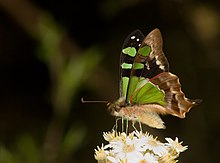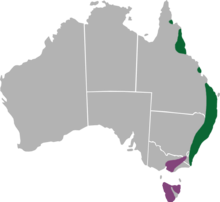Graphium macleayanus
| Macleay's swallowtail | |
|---|---|

| |
| Macleay's swallowtail (Graphium macleayanus moggana), Franklin-Gordon Wild Rivers National Park, Tasmania, Australia | |
| Scientific classification | |
| Kingdom: | |
| Phylum: | |
| Class: | |
| Order: | |
| Family: | |
| Genus: | |
| Species: | G. macleayanus
|
| Binomial name | |
| Graphium macleayanus | |

| |
| Range of Macleay's swallowtail G. m. moggana; G. m. macleayanus
| |
Graphium macleayanus, the Macleay's swallowtail, is a butterfly belonging to the family Papilionidae. The species was named after Alexander Macleay.[2][3]
Taxonomy
Macleay's swallowtail was first described by William Elford Leach in 1814. Two subspecies are recorded in Australia,[1] the nominate form, G. m. macleayanus and G. m. moggana, which was first described by Leonard Edgar Couchman in 1965.[4] The name is synonymous with Papilio macleayanus.
Description

The caterpillar grows to a length of 4 cm. The pupa is green with thin yellow lines.
The adult female Macleay's swallowtail has a wingspan of 59 mm, whilst the adult male has a wingspan of 53 mm.[5] The upperside of the wing is green with white markings and black edges.[6] The lower surface is a deeper green with black, brown and white markings.[6] The lower wings are strongly tailed.[7]
Distribution and habitat
The Macleay's swallowtail is one of the most widely distributed swallowtail butterflies in Australia.[8] It is found in eastern Australia including the ACT, New South Wales, Queensland, Victoria and Tasmania. It is the only swallowtail found in Tasmania.[9] The species has also been found on Lord Howe Island and Norfolk Island, but not since 1893.[1] The habitat of the species includes urban areas, forests, woodlands and heath.[10]
Behaviour
The caterpillars are green, with small white dots all over the body and a humped thorax. They feed on the foliage of members in the Atherosperma, Cinnamomum, Cryptocarya, Daphnandra, Doryphora, Endiandra and Tasmannia genera.[11]
The adults feed on nectar from flowers, including the genera Leptospermum, Lantana and Buddleia.[5] The flight period is from August to March.[12]
See also
- Papilionidae
- List of butterflies of Australia
- List of butterflies of Victoria
- List of butterflies of Tasmania
References
- ^ a b c "Macleay's swallowtail". CSIRO and Department of Agriculture, Fisheries and Forestry. 18 September 2004. Retrieved 4 November 2009.
- ^ Herbison-Evans, Don; Newman, Stewart; Crossley, Stella (5 September 2009). "Graphium macleayanus (Leach, 1814)". Archived from the original on 11 October 2009. Retrieved 3 November 2009.
- ^ Museum: the Macleays, their collections and the search for order. Cambridge University Press, 2007. 24 October 2007. ISBN 9780521874533.
{{cite book}}: Cite uses deprecated parameter|authors=(help) - ^ "Names List for Graphium macleayanus (Leach, 1814)". Department of the Environment, Water, Heritage and the Arts. 9 October 2008. Retrieved 4 November 2009.
- ^ a b "Macleay's Swallowtail ( Graphium macleayanus )". OzAnimals.com. Retrieved 4 November 2009.
- ^ a b "Graphium macleayanus – JCU". Archived from the original on 9 July 2009. Retrieved 26 August 2009.
- ^ Tasmanian year book, Issue 11. Australian Bureau of Statistics, Tasmanian Office. 1977.
- ^ Australian natural history, Volume 14. Australian Museum. 1962.
- ^ Butterflies of Australia and New Guinea. N. H. Seward. 1951.
{{cite book}}: Cite uses deprecated parameter|authors=(help) - ^ "Macleay's Swallowtail Fact File". Australian Museum. 4 November 2009. Archived from the original on 30 September 2009. Retrieved 4 November 2009.
- ^ "Host taxa for Graphium macleayanus (Leach, 1814)". Department of the Environment, Water, Heritage and the Arts. 9 October 2008. Archived from the original on 5 May 2011. Retrieved 4 November 2009.
- ^ Daley, Elizabeth (2007). Wings: An introduction to Tasmania's winged insects. Riffles Pty Ltd.
External links
- List of host plants for Graphium macleayanus. Australian Biological Resources Study.
